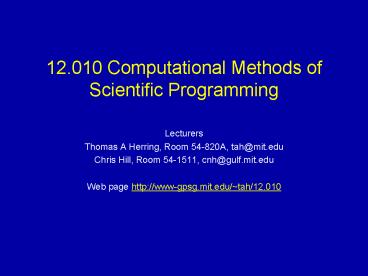12.010 Computational Methods of Scientific Programming - PowerPoint PPT Presentation
1 / 20
Title:
12.010 Computational Methods of Scientific Programming
Description:
Phase diagram generator for binary and ternary solid-state solutions ... A new development is fast computing is to use the computers Graphics Processing ... – PowerPoint PPT presentation
Number of Views:45
Avg rating:3.0/5.0
Title: 12.010 Computational Methods of Scientific Programming
1
12.010 Computational Methods of Scientific
Programming
- Lecturers
- Thomas A Herring, Room 54-820A, tah_at_mit.edu
- Chris Hill, Room 54-1511, cnh_at_gulf.mit.edu
- Web page http//www-gpsg.mit.edu/tah/12.010
2
Review of last Lecture
- Looked a class projects
- Graphics formats and standards
- Vector graphics
- Pixel based graphics (image formats)
- Combined formats
- Characteristics as scales are changed
3
Class Projects
- Class evaluation today
- Order of presentations
4
Advanced computing
- A new development is fast computing is to use the
computers Graphics Processing Unit (GPU) (not
Central Processing Unit CPU). - Drivers and software are available for the NVIDIA
8000-series of graphics cards (popular card). - Company http//www.accelereyes.com/ makes
software available for Matlab that uses these
features. - CUDA (Compute Unified Device Architecture)
software downloaded from http//www.nvidia.com/obj
ect/cuda_get.html
5
Example performance gains
- For image smoothing Convolution run on GPU
- Mean CPU time 7059.88 ms
- Mean GPU time 828.907 ms
- Speedup (CPU time / GPU time) 8.51709
- Matrix mutiply example by size
- In-class demo of raindrop example
6
FFT example
7
GPU processing
- Matlab interface is a convenient way to access
the GPU processing power but the documentation is
not quite complete yet and many crashes of Matlab
(even when codes have run before). - This type of processing will get more common in
the future and the robustness should improve. - NVIDIA GeForce chip set (plus other NVIDIA
processors). - Direct C programming is also possible with out
the need for Matlab
8
Review of statistics
- Random errors in measurements are expressed with
probability density functions that give the
probability of values falling between x and xdx.
- Integrating the probability density function
gives the probability of value falling within a
finite interval - Given a large enough sample of the random
variable, the density function can be deduced
from a histogram of residuals.
9
Example of random variables
10
Histograms of random variables
11
Characterization Random Variables
- When the probability distribution is known, the
following statistical descriptions are used for
random variable x with density function f(x)
Square root of variance is called standard
deviation
12
Theorems for expectations
- For linear operations, the following theorems are
used - For a constant ltcgt c
- Linear operator ltcH(x)gt cltH(x)gt
- Summation ltghgt ltggtlthgt
- Covariance The relationship between random
variables fxy(x,y) is joint probability
distribution
13
Estimation on moments
- Expectation and variance are the first and second
moments of a probability distribution - As N goes to infinity these expressions approach
their expectations. (Note the N-1 in form which
uses mean)
14
Probability distributions
- While there are many probability distributions
there are only a couple that are common used
15
Probability distributions
- The chi-squared distribution is the sum of the
squares of r Gaussian random variables with
expectation 0 and variance 1. - With the probability density function known, the
probability of events occurring can be
determined. For Gaussian distribution in 1-D
P(xlt1s) 0.68 P(xlt2s) 0.955 P(xlt3s)
0.9974. - Conceptually, people thing of standard deviations
in terms of probability of events occurring (ie.
68 of values should be within 1-sigma).
16
Central Limit Theorem
- Why is Gaussian distribution so common?
- The distribution of the sum of a large number of
independent, identically distributed random
variables is approximately Gaussian - When the random errors in measurements are made
up of many small contributing random errors,
their sum will be Gaussian. - Any linear operation on Gaussian distribution
will generate another Gaussian. Not the case for
other distributions which are derived by
convolving the two density functions.
17
Random Number Generators
- Linear Congruential Generators (LCG)
- x(n) a x(n-1) b mod M
- Probably the most common type but can have
problems with rapid repeating and missing values
in sequences - The choice of a b and M set the characteristics
of the generator. Many values of a b and M can
lead to not-so-random numbers. - One test is to see how many dimensions of k-th
dimensional space is filled. (Values often end
up lying on planes in the space. - Famous case from IBM filled only 11-planes in a
k-th dimensional space. - High-order bits in these random numbers can be
more random than the low order bits.
18
Example coefficents
- Poor IBM case a 65539, b 0 and m 231.
- MATLAB values a 16807 and m 231 - 1
2147483647. - Knuth's Seminumerical Algorithms, 3rd Ed., pages
106--108 a 1812433253 and m 232 - Second order algorithms From Knuthx_n (a_1
x_n-1 a_2 x_n-2) mod ma_1 271828183, a_2
314159269, and m 231 - 1.
19
Gaussian random numbers
- The most common method (Press et al.)Generated
in pairs from two uniform random number x and
yz1 sqrt(-2ln(x)) cos(2piy)z2
sqrt(-2ln(x)) sin(2piy) - Other distributions can be generated directly
(eg, gamma distribution), or they can be
generated from the Gaussian values (chi2 for
example by squaring and summing Gaussian values) - Adding 12-uniformly distributed values also
generates close to a Gaussian (Central Limit
Theorem)
20
Conclusion
- Examined random number generators
- Tests should be carried out to test quality of
generator or implement your (hopefully previously
tested) generator - Look for correlations in estimates and correct
statistical properties (i.e., is uniform truly
uniform) - Test some algorithms with matlab randtest.m































